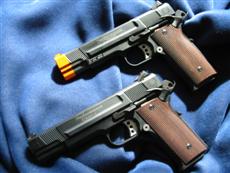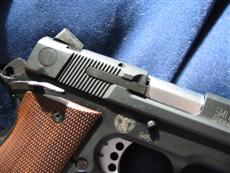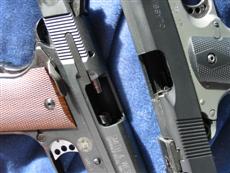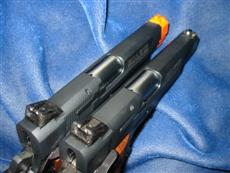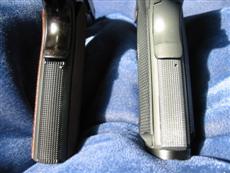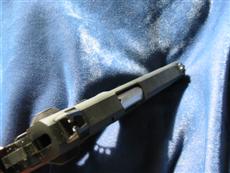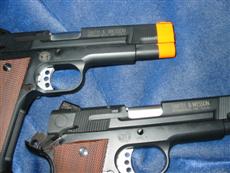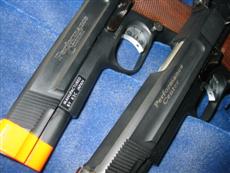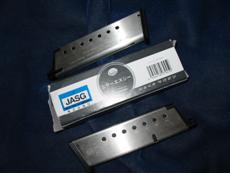Section I, Physical Description
As reflected by the comparison of KSC STI double-stacker 2011s to Western Arms SVI 2011-type double-stackers, both versions of the M945 are fully up-to-par with comparable Western Arms 1911 single-stackers in every respect of cosmetic refinement. The plastic has a very nice matte surface overall, and molding of the checkering on everything from the faux-wood of the grip panels to the frontstrap and the mainspring housing to the finely inscribed trademark symbols and trademark lettering (all over, including the gorgeous magazine) are again on-par with the best that anyone has to offer. Perhaps the most subjectively pleasing aspect of this piece, aside from the finely executed details, is the intricate slide profiling which is much more pleasant than the rather slab-sided profiles of the traditional 1911 and 2011-type replicas from Western Arms. Certainly, although KSC did not make true to their pre-production photos from the late 2002 BlackHole show in Japan, which used a Performance Center proprietary “fish-scale” slide cocking serrations as well as a target-type adjustable rear-sight assembly, the slide is still pleasantly handsome and masculine in a tactical fashion, and pairs well with the Novak’s-type rear sight. Another nice touch is the external extractor, which, as pictured above, has been molded into the slide in an “up” position to indicate a chambered round. This pairs well with the metal loading nozzle of this replica (available standard on both the Taiwanese and Japanese variants), which can be seen through the “loaded chamber” indicator holes/gaps at the rear of the outer barrel assembly – making it look as if this pistol is indeed “ready to rock” at a moment’s notice.
No molding seams are anywhere to be seen, as reflective of the superior level of final finish that’s achieved by the top makes. There is, however, a minor casting and paint defect at the end of the guide rod assembly, at the muzzle. This seems to be something within the mold, as it was present on both the Taiwanese and Japanese versions. Unfortunately, this defect was not able to be photographed. The lightweight aluminum outer barrel assembly shows the typical faux straight-line rifling that is seen with all of the WA 1911/2011 replicas. However, as you can see in the above picture, as the inner barrel is not as deeply recessed into the bore of the faux outer barrel as the WAs’ and since the faux bore rifling of the KSC is also not as deep as that seen with comparable WAs’, the overall final result also is not quite as pleasing. If there are any cosmetic disappointments, strangely, it can be blamed on the metal parts. Looking at the Novak’s-type rear sight unit (unlike the KSC STI-series, the M945s do not carry the Novak’s trademark) beavertail grip safety, ambidextrous wide/target-type slide/thumb safeties, as well as the S&W-type slide stop, one can easily see upon anything more than just a cursory inspection that there are many blemishes in the material. The uneven finish and often pot-marked surface is most obvious with the rear sight unit – thankfully, the beavertail is nicely smooth (if not altogether evenly finished) to-the-touch – such problems are typically seen only on much larger spans of metal on WA replicas, such as with the forward frame sections on their double-stackers or underslung Picatinny rails as on the single-stacker “Striker” (Springfield TRP Operator replica, trademarked Wilson Combat by WA), with the smaller parts usually showing excellent finish. This is a further disappointment not only in light of such cross-comparisons with WA pieces, but is rather very surprising in light of the typically excellent levels of metalwork on the KSC STI double-stackers. The flash-highlighted picture below illustrates this point clearly. And yes, both the Japanese and Taiwanese versions of the M945 unfortunately share these faults. Also disappointing is KSC’s decision to apparently not use their excellent proprietary “Cool-Touch” heavyweight slide material on this piece, which so nicely rendered the heavyweight version of the KSC Sig Sauer SigPro SP2009 to be convincingly “metallic.” The singular non-cosmetic, general-aspect disappointment is the lack of heft of this item. While most of the full-sized (i.e. 5” barrel/slide length, “Government”-sized) WA single-stacker replicas weighing-in between 925 to well over 1-kilogram, the KSC M945’s 800-gram weight (again, shared between both the Taiwanese and Japanese versions in an identical manner) is definitely a detriment when handing off this piece to a friend with the traditional Aliens “Feel the weight.” The difference is apparent despite the aluminum outer barrel and the metal guide rod (both well-painted with highly scratch-resistant surface matte finishes), even without having a back-to-back comparison. Unlike the difference in weight between, say, the KWC “high-grade” M92FS “Super” heavyweight (at 860+ grams) versus the some 100+ gram heavier WA Beretta M92FS Perfect Version black heavyweight version – which is only apparent under stringent examination – the difference between the KSC M945 versus, say, a WA Wilson Combat Service Grade CQB, is instantaneously obvious. With that said, however, the M945 still remains nicely balanced in one’s hands with its center-biased weight distribution; a trait that almost all airsoft GBB replicas owe to their metal magazines. Physically, the M945 is nearly identical in every measure to a standard single-stacker 1911. Put a WA next to the KSC, and there’s very few measures setting the two apart. The grip is a major area of difference, which I will cover in-detail in Part C., but the most obvious difference externally that the M945 is just ever so slightly longer than the standard 1911s. Measuring from the end of the slide, at the muzzle, the M945 is about 5/16-th of an inch longer. Taking into account the protrusion of the barrel of either a bull/cone/”corn” barrel fitted WA 1911 or the same item’s barrel bushing section, we get a difference of about 1/8-th inch only. The sighting radius should prove to be relatively consistent between the two, however, as although the M945’s front sight post is set more forward on the slide, its rear sight is also more forward displaced, thus effectively canceling out any such differences. As a matter of fact, aligned side-by-side, the BoMar set on typical WAs actually has a slight advantage. B. Loading and magazine capacity: Gas loading with this replica’s magazine is no different than with any other GBB – invert the mag and fill bottle, and press down hard enough to actuate both valves. A typical HFC134a fill takes about 5 seconds, with higher-pressure Taiwanese “Green Gas” fills typically taking 3 seconds before “spit back” full-load sign is seen. Both Taiwanese and Japanese M945 magazines show the same approximate gas reservoir capacity. Both are capable of discharging their full mag BB load before requiring refill, using either gas. As with most KSC replicas, the M945 utilizes a special notched detent at the bottom-most compression of its BB-follower travel to lock the spring and followers in-place during BB loading. Since most hobbyists prefer to “hand load” their GBB magazines with BBs instead of using a loading rod (which is something that most KSC pieces do not use, and simply are not supplied with – this is true of the M945, no such accessories are included), this lock-down feature is much appreciated.
Once this single-stack magazine is fully gassed and loaded to-capacity (15x 6mm BBs, identical to the WA single-stackers), typical 1911/2011 loading and chambering procedures do as well for the KSC as it does for the WA replicas of these fine firearms. Rack and lock back the slide. Inspect chamber. Lower the slide and engage the thumb safety. This procedure assures that you will not initially double-feed nor bang the internal hammer/valve-striker/firing pin assembly on the rear main magazine rear valve piston protrusion. Loading a “live” BB is as easy as tripping off the wide thumb safety and racking the slide back smartly and letting it fall back to battery under the tension of its recoil spring. Ironically, easing the slide forward into battery is not recommended with the KSC replica as the recoil spring seems to be somewhat deficient in its ability to push forward the slide, and can cause a misfeed – this will be addressed in Section III. Also not recommended is the 1911/2011-user preference of holding back the trigger while allowing the slide to come forward into battery. Although the WA replicas show excellent hammer-to-sear engagement, the KSC M945 shows a distinct tendency of the hammer to “follow.” Although I have not been able to cause a discharge of the gas-valve from this unsafe following of the hammer, which is a huge concern with real-steel 1911’s/2011’s and aftermarket “trigger jobs,” this shortcoming can and should still be of concern to the airsoft shooter. Extra safe handling should be noted – finger off the trigger!
And here’s where this replica truly shines. Unlike the WA 1911/2011-type replicas, the KSC M945 – both Taiwanese and Japanese versions – has nothing short of a phenomenal trigger feel. Nominal trigger pull is just at 1/16-th inch, with a very light overall pull that is likely within the 2 to 3-pound range. This is not a GBB to hand off to your new-to-GBB pistols friends with a loaded magazine. Just as any real-steel competition firearm with a proverbial “hair-trigger,” even experienced shooters should use caution. With such a light and positive trigger (which at the same time is also unbelievably smooth and crisp), cycle time, especially when paired with the lightweight slide that KSC chose to use on this piece, double-taps are as easy as pie. Sure, it doesn’t cycle really fast enough, even with the above considerations, to be a true “fire as fast as you can pull the trigger” 1911/2011-type replica – but honestly, that is typically reserved for either a WA factory-tuned piece (such as the SVI Championship .45, which is essentially a Mercedes or a BMW loaded full of AMG or Moterwerks OEM aftermarket parts) or a well-tuned/customized airsoft 1911/2011-type replica. Truly, outside of such framework, this GBB, again both the Taiwanese as well as the Japanese versions, stands alone as having undoubtedly one of the best trigger feels in the 1911/2011-type replica genre. Once you’ve expended the magazine, the slide is “tactically” locked-back on the empty chamber. Dropping the spent mag is a simple matter of just slipping the frame around a bit, as with all 1911/2011s, and tripping the large, extended magazine release button; allowing the magazine to drop free. Thanks to the rather unique frame size as well as the ultra-thin grip panels fitted to this piece, those of you with larger paws should actually be able to trip the mag release with your shooting-hand thumb without even the need to shift the frame. Instead of the usual single-stacker 1911’s 5 and ½ to 5 and ¾ inch taper circumference, the M945 remains a consistent 5 and ½ inch top-to-bottom – with the actual “width” decreasing from a nominal 1 and 1/4 to a thin 1 and 1/16-th. But let’s revisit the magazine release button for a bit….. What is strange here is that although fixed Novak’s rear sight assembly would seem to definitively point to a “tactical/carry” use of this item – pegging it for the skirmish field – KSCs decision to fit such an obtrusive magazine release suggest to all the world’s 1911/2011-enthusiasts to signify a distinctly “target” or competitive sporting use of this piece. To say the least, we have a conflict here. Want to carry this piece “tactically” and use it in a skirmish? I would not even hesitate a second to say that you should remove the extended mag release button. Regardless of which type of grip you favor, left or right handed, your fingers or hand will variously interact with or otherwise come within extreme proximity of the larger button – none of which can be said to be ideal during a skirmish situation. And furthermore, the enlarged and extended button also will increase the chances of it being actuated accidentally by a holster lip or by interactions between your holster rig and your body, leading to magazine loss. But even after you’ve removed the enlarged button head, a big concern still remains. The M945’s lightweight slide has a strong tendency towards blowback shock damage (to be addressed later, see Section IV) – which essentially limits the use of this piece to only true HFC134a and thus makes for extremely low muzzle energy output (also to be addressed later, see Section III). This unfortunately would definitely also make me shy away from such recommendations of skirmish-gaming use to any of my friends….. Ergonomically, I’ve already addressed the nature of the grip panels, mag release, and wide ambidextrous slide safeties (Ed Brown/Wilson #423-type) – much of the rest simply conforms to “normal” 1911/2011-type replicas. The rear high-ride (Wilson Combat-type) beavertail shows a recess for the hammer as well as a thenar swell to both aid in getting the highest ride possible on the backstrap as well as insure positive engagement of the safety mechanism by the shooter’s hand. Meanwhile, up front, a large, traditionally considered “Combat Plus” sized slide release insures proper actuation of that lever as well. Perhaps the most outstanding consideration to modern ergonomics is the rather enlarged and undercut trigger guard. This allows for both a very nicely extended, drilled aluminum trigger (patterned after the popular Wilson Combat/Videki) designed to minimize inappropriate trigger interactions as well as allows for even the large-handed among us to wear rather bulky gloves and still engage the trigger in a positive manner, without interference from the forward edge of the trigger guard. At the same time, you’ll the smooth undercut allows one’s middle finger to nicely snug-up high on the grip frame. However, as I’ve cited above, it’s rather hard to get a good, positive grip on this piece using either a “tactical” “thumbs-down” grip (right handed, here both your shooting hand middle finger – ironically thanks to the high-ride of the undercut trigger guard as well as your support hand thumb are both in danger of tripping the large mag release button), a left-handed grip (where both your trigger and middle fingers are in danger), or even a “competition grip” (right handed, support thumb pointed forward along side of frame, shooting hand thumb locked over the slide safety’s wide rest, those of you with “fatter” hands can cause the pad/webbing between your support hand’s index finger to thumb can also endanger mag drop) – all thanks to the pesky enlarged mag release button. Another item of worry, for me is seen with the slide/thumb safety. Although positive and sure in its engagement, it nonetheless does not engage “all the way up” into the slide detent cut-out (look above above at the second picture in this review, see the difference?). Is this a concern for competitive sporting use? Not likely. But it does present a slight worry in my mind for skirmish-use “Condition One” carry. Honestly, the Western Arms replicas do this much, much better, and their thumb safety engagement is also much slicker and more positive than that seen with this KSC. Again, this is something that is present on both of the M945 versions, Taiwanese or Japanese. Both sides of the ambidextrous safety, however, engage with equal ease – that is if the slide is properly back at-battery/lock….. This is another item which I will address later, in Section III.
My wife doesn’t allow me to collect real-steel firearms, so, I’ve avoided them in order to just plain avoid temptation. The following information comes directly from posts made on the AirsoftZone.com informational discussion forums by fellow enthusiast Matt Hoffman ( contact: mchoffma@uiuc.edu ) of Champaign, IL, USA. My deepest thanks go out to him for supplying this information, which I had not been able to dig up in my feeble attempts at research, and to his permission in letting me directly quote from his posts.
Note, of course, that the above quote is strictly applicable to the real-steel, and also contains quite a bit of Matt’s “personal-takes.” Other real-steel info. is presented in the following two pages: For a second presentation with more “lineage” information of the M945, I will again reference the Arnie’s UK hobbyist article, which contains information from the late 2002 BlackHole show in Japan, and is written by well-known airsoft-gunsmith Clarence Lai. The differences between the real-steel and the airsoft versions, which I’ve addressed, should be apparent if you’ve carefully read my review thus far. This can also be said to be true of the differences between the pre-production version that Clarence handled above, as compared to the current-production versions that I’ve addressed in this review. One item that I’d like to specifically point out is the use of the much touted spherical barrel bushing that has been so highly advertised by both KSC as well as was so highly anticipated by the hobbyist community.
Certainly, the airsoft version is quite “neato” and very well made, but in execution, it barely improves over even the traditional full “solid” barrel-bushing system that is favored by Western Arms for its various replicas. And actually, even in the real-steel world, as you can well search out on enthusiast discussion-boards and Forums such as that on the Brian Enos page, the spherical bushing hasn’t been all that it’s cracked up to be. While it can definitely offer a measurable improvement in lock up as compared to most factory-OEM/stock barrel bushings as typically seen on 1911s and 2011s, it has been pointed out by many enthusiasts that such improvements can easily be exceeded through an expert-level custom fitment of a traditional full solid barrel bushing. This is definitely something that’s confirmed by an examination of the airsoft replicas as well. Like I said above, yes, the spherical bushing system seen with either the Japanese or Taiwanese M945s really do offer a slightly better lock-up at the muzzle than what is seen by the traditional full solid bushings used by WA on their 1911s. But at the same time, moving to a true custom-build piece, such as that seen with my Clarence Lai AirsoftSurgeon “Twins,” Dexter and Sinister, you can actually see that the custom fitted traditional barrel bushings will literally offer, as with their real-steel counterparts, no slop. That kind of precision fit is unfortunately not able to be achieved regardless of how well-made a mass-production item may be or how sound its theory in execution. It’s simply a matter of a precision unique fit that can only be hand-made. Regardless, this is again a case of “if it works so well, then all of the top shooters would be using it.” And conversely, as it hasn’t truly proved to offer its theoretical advantages in actual practice, most of the top shooters still favors a hand-crafted, detail-mated full traditional barrel bushing made by the hands of an experienced gunsmith. B. Manufacturer Information: As I’ve already addressed above in Section I, KSC has had a long history of making excellent airsoft replicas of all types. From their legendary Ingram/Cobray M11A1, Glock 17, 18C, and 19 pieces to the wonderful SigPro-series, HK Mk23 Mod0 SOCOM, STI-series, and M93R replicas, this marque has made a wonderful reputation for itself in both terms of functional durability/reliability and performance, as well as in the area of cosmetic build and aesthetic refinement. Overall, the M945s are just as on-par with their main competition – the WA single-stacker 1911s – as any of the above GBBs are with their own respective competitors. Certainly, they’re not without faults – in many cases, as with the subject of this particular review, these different factors of cosmetics-vs.-durability-vs.-durability can be self-contradictory. Making a durable item doesn’t necessarily equate to having an item that is cosmetically refined. And having a pretty exterior doesn’t necessarily mean that performance will match. I will address these issues in Section IV. Section III, Performance Test Results At a standard range of 5 meters (appx. 18 ft.) distance that’s typical for such performance judgments, we see an average 2-inch grouping. Shots at appx. 10 to 12 meters (between 35 to 40 ft.) show that staying within a 5 inch diameter circular target can be consistently expected. Both the Taiwanese and Japanese versions showed nearly identical results. This performance is on-par with that seen from a comparable inner-barrel length, Hop inner-barrel equipped Western Arms traditional 1911 single-stacker, which usually groups within 1 and ½ to 2 inches at 5 meters. By these objective measures, this can easily be said to be skirmish-viable performance and should also be suitable for stock/unmodified class BB-IPSC use. The front sight bead, larger than the rear dots, is an excellent touch which helps in low-light shooting and in acquisition of the front sight against a dark background. Factory alignment of the front to rear dots is excellent, with precise top-edge alignment of the sight post within the rear notch also precisely aligning the three dots horizontally in-plane and in-line. Subjectively, accuracy was no doubt improved by this factor. With HFC134a and 0.20 gram BBs, an average muzzle velocity of around 215 fps. at normal room temperature (68-72 deg. F.) is achieved with skirmish-optimized Hop setting. This is disappointingly low, considering that a comparable WA single-stacker should easily achieve 230 to 250 fps. with a similar setup. With use of Taiwanese “Green Gas,” velocity is boosted to 295 to 300 fps. under the same conditions. This more falls in-line with what can be expected of typical WA single-stackers with similar gas-pressure boost. All velocities were chronograph verified. This is again similar between both the Japanese and Taiwanese versions of the M945. Cyclic rate is good with HFC134a, which, with the KSC M945’s lightweight slide, easily cycles faster than a comparable WA fitted with its heavyweight slide, using the same gas. Drop the WA slide weight to a lightweight model, however, the cyclic rate is seen to equalize. This same ratio of cyclic rate can be seen with high-powered Taiwanese “Green Gas” use. Slide action is very smooth – but it is no more or less so than a lightweight slide equipped WA 1911/2011-type GBB replica. Unfortunately, however, due to the rather “lazy” recoil spring on the KSC M945, there’s a troubling tendency for the replica to not return the slide fully back to forward battery/lock during manual cycling. The slide on neither version of the M945, however, binds or sticks during normal use, including when dropping the slide on a reloaded magazine with the slide stop. But like I said back above at the end of Section I, this deficit in achieving lock with certain manual manipulation techniques should not be overlooked by either the skirmish shooter or the sporting shooter. Make sure that your slide goes back fully into battery/lock by smartly racking or by using the slide lock release lever during reloads. Combine this tendency to not fully return to battery during manual manipulation of the slide with the hammer-following and the rather shallow slide safety detent lock (on a WA, to wit, you can see that the thumb/slide safety will engage FULLY into the detent, no questions, no doubts), and one is left to wonder about the absolute safety with which this item may be carried, as with all single-action 1911/2011s, in “Condition One.” Blowback feel is crisp – however, due to the lack of slide weight with the M945, felt “recoil” is low. Even the WA lightweight 1911/2011-type slides will easily overpower the M945s in this subjective measure. Section IV. Final Observations: And here’s where I’ll first remark on the oft cited durability concerns that I consistently alluded to throughout the above passages. With the above cited power deficit on HFC134a, any red-blooded airsoft hobbyist would be tempted to use higher-powered Taiwanese “Green Gasses” with this piece. Right?
Look at the damage incurred on the Taiwanese version that I have pictured below. See that split along the muzzle? That’s the exact same pattern that was seen many years ago with the first of the KSC Glock 18C replicas and was later also reported to have stemmed from the twin barrel porting cut-outs on the KSC Sig Sauer SigPro SP2009 GSG9 Limited Edition version. The combination of the apparently lightweight slide with the increased blowback shock forces – combined with the M945’s lack of any form of a shock buffer mechanism – is likely to fault for this damage. However, unfortunately, I cannot verify with 100% certainty, that the above damage was indeed caused by such recoil forces. Why? Well, take a look at this following photo. This shows the Taiwanese replica (we’ll get to how to tell the replicas apart in just a minute) with what appears to be a paint defect on the slide. Upon removal of that paint, as seen with the previous two pictures above, you saw that it is actually the slide that’s cracked, which is what caused the apparent paint defect. On closer inspection, you can actually tell that the paint is INSIDE the crack fissures – evidence that whatever damage happened BEFORE the item was shipped; before even the US-import required muzzle orange paint was even put on. So had the item been dropped or otherwise mishandled? Did the pre-shipment testing from the import source cause the damage? No one can tell for sure – all that can be said is that the damage is consistent in patter configuration and physical presentation in terms of high-powered gas-use induced damage. And regardless of how the damage happened, it nevertheless remains a point of great worry. This worry, of course, is only magnified in that as of the writing of this article in March, 2003, there has yet to be any aftermarket replacement/upgrade slide on-market for this piece – Taiwanese or Japanese. And speaking of which, this has also been a topic that I’ve received many e-mails and questions about – how to tell which replica is truly Japanese, and which is Taiwanese. At first this may seem impossible, but it’s actually quite easy. There’s usually a sticker on the Japanese-made KSC M945s, on the left hand side of the frame, at the edge of the dust cover, that says “MANUFACTURED (linebreak) BY KSC JAPAN” – you’ll see this on the first photo way up at the beginning of my reivew. At the same time look on the outside of the box. See how the Japanese model has that red JASG sticker and a serial-number sticker – and how the Taiwanese piece doesn’t?
Of course, this is all rather easy to fake....... But what cannot be faked is that the serial number on the sticker should match the UNIQUE serial number on your replica. Left side of the frame, just under the slide lock, should be a serial number that begins with an “XJ” prefix. My number is XJ802060, as depicted both on the box and on my replica. Look at the picture I’ve taken before, which showed you how the magazine follower locked down. Right underneath the slide lock lever, you can clearly see my unique serial number. Note here, on this Japanese enthusiast’s website, the second to last photo clearly shows his piece to also begin with an “XJ” prefix, but that his serial number is distinctly different from mine in at least one digit, clearly and obviously (we’ll even discount all the other digits as they can be mistaken, but that “1” in the middle clearly is not). Meanwhile, the Taiwanese pieces all share the same serial number – XPX0247. Also, look at the serial number inscription….and flip the GBB over to the other side and look at the trademark inscriptions on its right side, both the lettering and the S&W crest. What do you notice in the comparison photo above? The Taiwanese model’s serial number and the S&W crest logo are quite “dark,” aren’t they? This is opposed to the Japanese model’s, which are clearly and well highlighted in contrasting color. Sure, that can be faked by application of some enamel or paint, but what cannot be denied in looking at the right side trademarks are the different ways in which the Taiwanese and Japanese models carry out the “SMITH & WESSON” inscriptions on the slide. Look back at the previous picture, carefully, again at the Taiwanese model (lower, no barrel orange) that I photographed in comparison to the Japanese model above it – the Japanese bears barrel orange, just to make it easier for distinction. See how the Japanese model’s “SMITH & WESSON” lettering is a sharp, single-line script, while the Taiwanese is a softly curved double-line outline? That’s tale-tale. Now look below at the place-of-manufacture lettering. See how again the Japanese model’s is sharper and narrower, while the Taiwanese model’s has more rounded edges? That’s also definitive. Look also at the comma and period marks. This time, the Japanese model has an outline shape and is sharply defined. Meanwhile, the Taiwanese has filled in those same holes. Again, undeniable proof between the two. While we’re on lettering, let’s flip back to the left of the GBB. Look at the “C” of the “Performance Center” script. The Japanese model (above, with barrel orange) has a “C” that drops BELOW the line of the script. The Taiwanese (below, no barrel orange) has a “C” that rides on the line of the script. Again, this is uncontestable proof of make/origin. Both models, unfortunately, carry the JASG marking under the dust cover forward of the trigger guard, and both also have a KSC corporation marking buried under the slide lock lever.
Finally, with the magazines…… They’re almost completely identical, with the exception of a very, very small “S&W” trademark WITHIN the very front portion of the baseplate, underneath, in the semi-crescent cut-out at its forward edge, on the true Japanese model (unfortunately not able to be photographed). A blue JASG sticker will accompany the box for this spare magazine. The true Japanese magazine will also be fitted to the true Japanese model GBB. No materials differences are noted, no cosmetic finish differences outside of those mentioned above. Pricing
for the Taiwanese version is around $105 overseas. The Japanese
version around $150. Add about $25 for shipping if you live in
the US. Competitive stateside prices should reflect that addition.
Mine was purchased for $226 Stateside (including a spare mag,
which usually commands around $40 HK, before shipping, $50 Stateside),
including shipping, from the well-reputed Olympus
Airsoft high-end
broker/re-seller. Very fair price. Deunan/GugesMk3 (Chris), the head of Olympus Airsoft, which is an authorized representative of Wargamer’s Club Shop here in the US, was not only extremely receptive and prompt in his initial shipping of the item, but was also absolutely up-front and totally helpful when I started running into problems. The first issue was that I had confirmed through him that I was paying for a true Japanese version. Once the item arrived, this did not hold up to inspection – but to Deunan/Olympus Airsoft’s credit, he/they also did not know of the differences between the Japanese and Taiwanese versions at the time of disbursement to me, and had been told by their supplier, WGCS, that they’d been shipped a Japanese version (which, of course Olympus paid for). When I alerted Deunan/Olympus of this issue and submitted the above proof (I used a combination of commercial sites, official KSC press-releases, as well as hobbyist sources such as the Japanese hobbyist site I cited), he immediately offered compensation. At that point, I had decided on an “additional mag” compensation, as that would have neutralized the cost differences between the two versions, but upon recovery of the muzzle orange, I ran into the pre-existing muzzle damage that was apparently covered-up by the supplier. And here, Deunan/Olympus brokered a fast and complete settlement with Wargamer’s Club Shop, and immediately sent my replacement Japanese version (which also ironically made this review so complete). Honestly, had it not been for Deunan/Olympus Airsoft’s help, I do not know how long this return process would have drawn out, nor how much extra I would have had to spend in return shipping! Deunan/GugesMk3/Olympus Airsoft deserves special mention for a job well-done and excellent customer-service, even post-sale! =)
Despite refined cosmetics and an excellent trigger, the apparently problematic lack of durability as well as a complete lack of any aftermarket upgrade/replacement parts for the critically damaged slide rules out any kind of serious use of this piece. HFC134a delivers sub-par power; and Taiwanese “Green Gas” makes that damage all too likely. That’s not practical at all for any type of use. Certainly, at its relatively low cost and with its unique features, it will be a nice addition to the collection of anyone who is a GBB 1911/2011-genre fan, but aside from that, I find it hard to for me to recommend this piece to anyone. Again, I’m left to the old standard of recommending only true Western Arms 1911/2011-type GBBs to those who wish to either skirmish with a 1911/2011, or those who desire using such pieces as bases for competitive sports shooting. Allen
PS: A final item of distinction. The Taiwanese model will arrive with literally only the KSC operator’s manual for this piece. Meanwhile, the Japanese model will arrive with the manual, a 2002 KSC product line complete catalog, as well as all of the documentation and registraion material seen below. A Hop adjustment tool should be included with either model. The tools are cross-compatible. External Links: TBA Site links: TBA Comment on this article in the forums Last modified: Sunday, March 30, 2003 5:39 PM Copyright ArniesAirsoft
|
